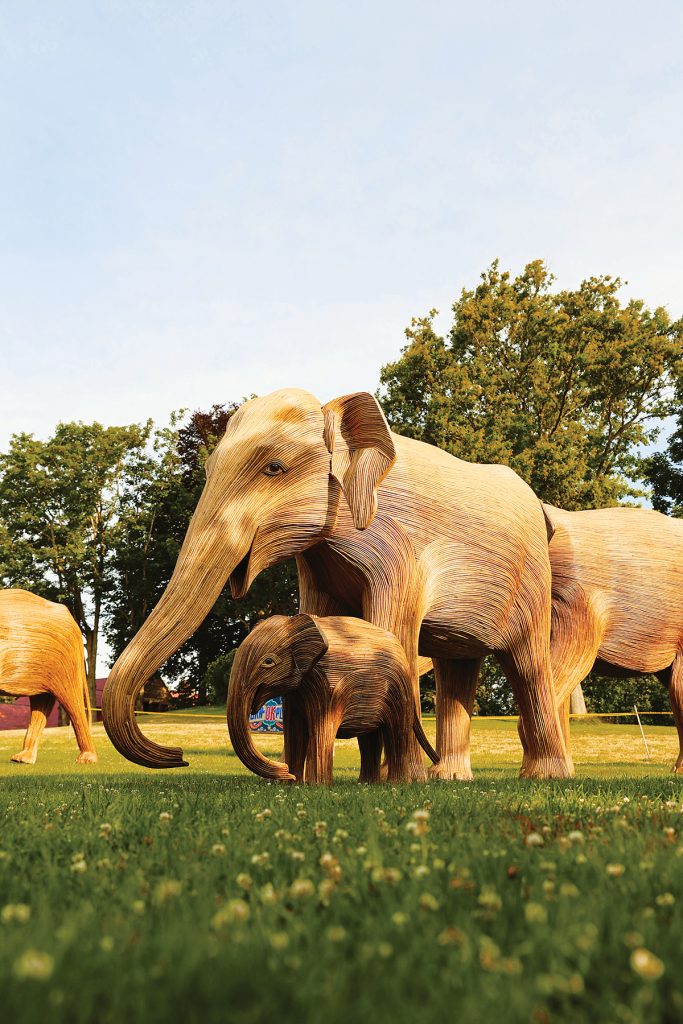
On July 3rd, 2024, The New York Times ran an article: “A Ban on Elephant Hunting Has Collapsed. Or Maybe It Never Existed.” It goes on to report, “Since September, five bull elephants from a population centered around Amboseli have been shot and killed, most likely by trophy hunters.” On July 4th, a public art installation and tourist attraction opened at The Breakers in Newport, titled The Great Elephant Migration; A Coexistence Story.
The international politics of hunting for elephants is complicated. The five killed bulls were part of a herd that moves back and forth between Kenya and Tanzania. According to the Times, “Kenya forbids hunting and gets all its wildlife revenue through sightseeing. While wildlife spotting safaris are an important part of the Tanzanian economy, the country also permits wealthy tourists to shoot big game.” Tanzania is by far the most impoverished of the two countries, having a Gross Domestic Product per capita of roughly half of Kenya’s. There is significant tension between the two countries over how to use their shared elephant herds as a resource; this has been going on for decades. What is most important in terms of viewing The Great Elephant Migration is acknowledging that there are people, mainly men, and mainly from the north, who give million dollar bribes to impoverished countries to allow them to slaughter these magnificent animals and hack out their tusks as trophies.
“It is absurd for a man to kill an elephant… it is not heroic… it is just one of those preposterous things that men do…” Beryl Markham, West with the Night
As someone who believes that art can change the world, I am excited to read about what this project is trying to accomplish. According to their website, thegreatelephantmigration.org, “they want to inspire the human race to share space… raise millions of dollars to power human-wildlife coexistence projects and protect migratory animals.” The means to accomplish these goals is to bring a migrant herd of 100 life-sized elephant sculptures from India in the Global South to the Global North, with Newport as the first stop on a tour of the USA. The hope is that the experience of viewing this artwork will change hearts and minds and loosen purse strings.
The bottom line with art is how it looks, right? Well, these elephants are beautiful and evocative. They ride the line between realism and abstraction in a manner that invites close examination of each individual sculpture. They feature texture, pattern, subtle shifts in color, and reflected light in intricate ways. They are arranged in family groups that pull at your emotions and suggest complicated stories. The herd as a whole flows across the lawn in a manner that enlightens you to their existence as a migratory but integrated community. As a visual experience, The Great Elephant Migration: A Coexistence Story is not to be missed. See it sometime before the beginning of September, when the migration will continue across the U.S. to New York City, Miami Beach, Montana, and Los Angeles. You won’t be disappointed.
The broader goals of presenting a public art experience are more challenging to evaluate. In terms of bringing about a change in consciousness about coexistence, this project is a drop in the bucket at best. It will draw people inclined to compassion for animals, and those who don’t share that inclination will stay away. Perhaps the organizers should have planned an installation outside the Atlanta Convention Center, where the National Rifle Association is holding its annual meeting in April 2025.
However, this project is in no way controversial. Conversely, it seems to want to charm people into changing. “Newport, Rhode Island, that breeding place–that stud farm, so to speak–of aristocracy; aristocracy of the American type.” Mark Twain The elephants are spread around Newport, but most are on the lawn of Salve Regina University, where the annual costs are $68,650 for tuition, fees, housing, and food. A small group is located on the grounds of The Breakers, a symbol of the Gilded Age, excess, and inequality. This project provides an “exit through the gift shop” fundraising strategy on steroids. One of their principal sponsors and gift shop stockers is Love Brand & Co., where a pair of embroidered swim shorts will set you back $235, and a matching polo goes for $140. You can also buy an elephant sculpture: baby – $8,000, adolescent – $14,000, matriarch – $18,000, and tusker – $22,000. They may, in fact, raise a lot of money. However, it all seems suspect, especially since the statement that the funds raised support “coexistence projects” is rather vague.
The Great Elephant Migration; A Coexistence Story is an invented, fanciful migration of animals. It is being presented when our country cannot reach a consensus on a tragically real migration coexistence story. The whole future of our country may be shaped by our ability to achieve human coexistence with people seeking to become members of our community. Enjoy the hell out of the art show but keep this in mind. •